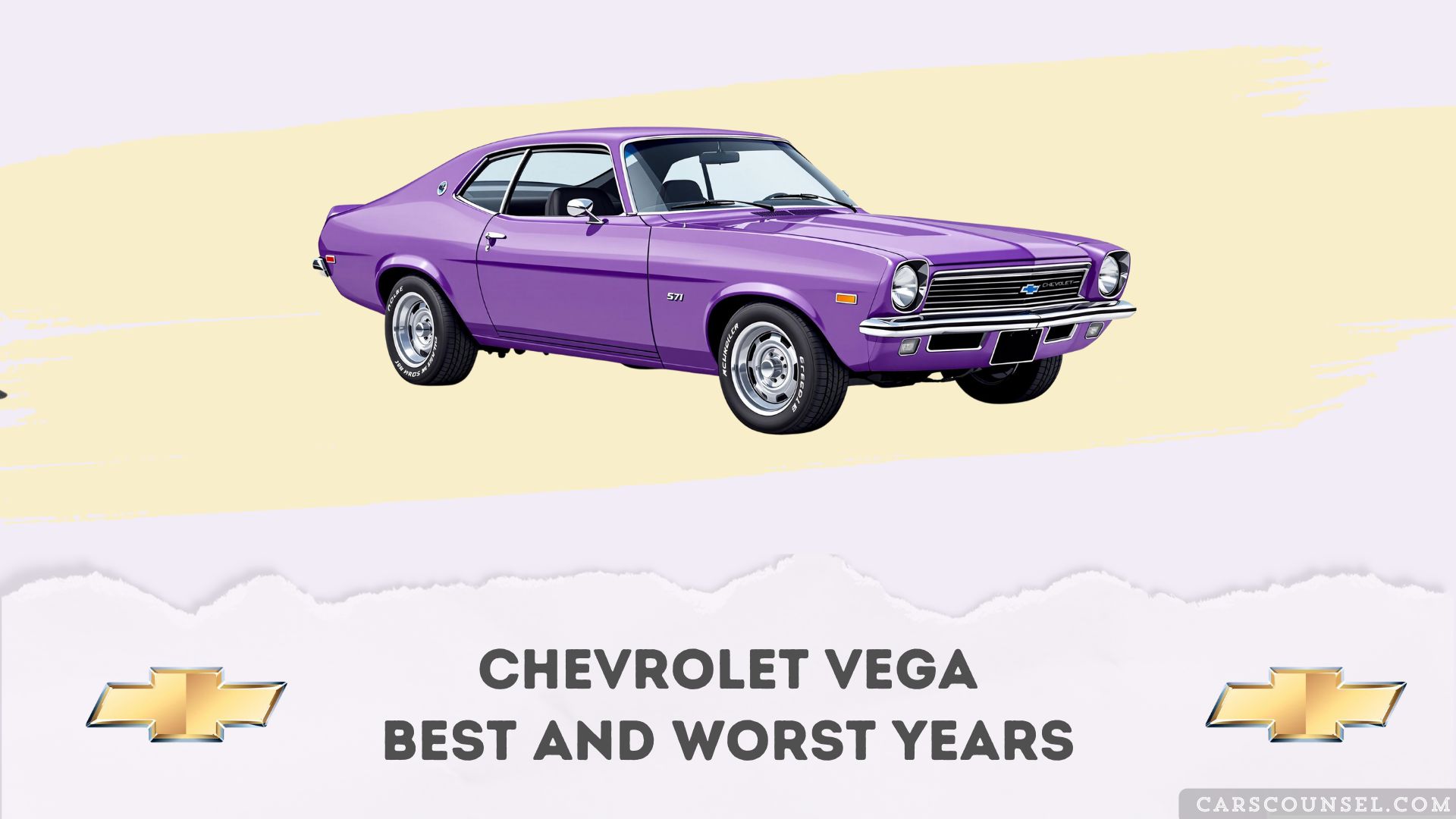You might think the Chevrolet Vega was a lost cause from the start, but that’s not entirely true. In fact, the Vega’s worst years were a result of a rushed production process, which led to a chaotic launch and numerous defects.
But, what’s often overlooked is that the Vega’s best years were marked by significant improvements, and we’ll delve how those changes impacted the Vega’s legacy. Let’s take a closer look at the Vega’s journey and what made its best years stand out.

Quick Navigation
Key Takeaways
- The 1971 Vega had major growing pains, with poor execution and numerous problems, earning it the title of one of the worst.
- The 1973 Vega GT package added sport suspension, wide tires, and a distinctive stripe package, making it a more appealing option for enthusiasts.
- The 1974 Vega introduced a modern dashboard and improved seating, making it a more comfortable and attractive choice for buyers.
- The 1975 Cosworth Vega set a new standard for the model with its high-performance capabilities and exceptional handling, redeeming the Vega’s reputation.
- The Vega’s worst years were from 1971 to 1972, with massive recalls, safety hazards, and reliability issues, damaging GM’s reputation and market share.
Conception of the Chevrolet Vega
As General Motors‘ chairman, Jim Roche announced a groundbreaking small car that would weigh less than a ton, cost less than the Volkswagen Beetle, and feature an advanced aluminum engine, surprising outsiders who were unaware of the problems within GM’s walls.
You’re looking at the conception of the Chevrolet Vega, a car that existed only on paper.
Ed Cole’s insistence on using aluminum engines, which were expensive and resulted in a tall, top-heavy design, replaced Chevrolet’s low-cost iron engine.
This decision would impact the Vega’s development, but that’s a story for another time.
Development and Launch
As you delve into the development and launch of the Chevrolet Vega, you’ll discover that Ed Cole’s corporate mandate forced the adoption of the XP-887 design, which ultimately led to an engine debacle.
You’ll see how the Vega’s original goals, including a sub-ton weight and a price tag under the Beetle’s, were gradually abandoned.
You’ll learn how these changes impacted the final product, including the addition of premium trim and a name that tied into the space program.
Corporate Mandate
Ed Cole’s executive decree forced the Chevrolet division to abandon its own subcompact car development and instead adopt the XP-887 design, which would become the Vega.
As General Motors’ executive vice president, Cole’s mandate was to create a transformative small car that weighed less than a Volkswagen Beetle and used an advanced aluminum engine.
However, Pontiac was cut out of the development process, and the XP-887 design didn’t meet cost and weight goals.
The corporate financial staff ultimately rejected the upgraded trim, leaving you with a premium-priced Vega that failed to deliver on its promises.
Engine Debacle
You’re left with an engine that’s a far cry from the innovative, game-changing powerplant General Motors touted.
Ed Cole’s insistence on an aluminum engine led to a tall, top-heavy design, increasing costs and weight.
The iron head and long stroke compromised performance and fuel efficiency.
The aluminum engine block’s silicon-impregnated-aluminum cylinder bores lost lubricating effectiveness over time, causing piston scuffing and high oil consumption.
Valve stem seals leaked, and radiator issues plagued the engine, all due to rushed development and poor quality control.
The Vega’s Reception and Initial Problems
The 1971 Chevrolet Vega’s arrival was met with surprisingly positive media reception, with John DeLorean extolling the virtues of the Vega’s cutting-edge automation.
You might’ve thought this subcompact was a game-changer, but it wasn’t. Car magazines praised its styling and handling, but flagged braking stability as a serious issue.
Motor Trend named it Car of the Year for 1971, despite its poor execution and numerous problems.
The iron cylinder head gasket would soon become a major headache, literally – it threw off so much heat you could cook on the hood.
It was clear the Vega had some major growing pains.
Chevrolet Tries to Fix the Vega
Chevrolet’s response to the Vega’s initial problems were swift and decisive.
You’ll notice significant improvements in the 1974 Vega, which was revamped to boost fuel economy and reduce emissions. The engine was redesigned, featuring a new catalytic converter and modified cylinder head.
Additionally, the braking system got an upgrade with revised brake pads.
If you’re looking for decent performance, the 1975-76 Cosworth Vega is the way to go, boasting a 110-hp engine, along with a more aggressive suspension.
These changes demonstrate Chevrolet’s commitment to fixing the Vega’s initial issues.
The Vega’s Negative Impact and Legacy
As the Vega’s problems mounted, its impact on General Motors’ reputation began to manifest in tangible ways.
You saw GM’s reputation take a hit, leading to a decline in customer trust and a loss of market share.
The company’s financial struggles in the 1970s were partly due to the Vega’s poor quality and reliability issues.
- The Vega’s failure damaged GM’s reputation, leading to a decline in customer trust and a loss of market share.
- The Vega’s poor quality and reliability issues led to a decrease in GM’s market share, with the company’s financial struggles in the 1970s being partly attributed to the Vega’s failure.
- The Vega’s failure served as a cautionary tale for automakers about the importance of quality control and customer satisfaction.
Specifications and Additional Information
You’re now looking at the nuts and bolts of the Chevrolet Vega, which was produced from 1970 to 1977. The Vega came in 2-door, 4-passenger, front-engine, RWD sedan/hatchback/wagon layouts, with a wheelbase of 97.0 in.
| Specification | Value | GT Package |
|---|---|---|
| Engine | 2.3L SOHC 8-valve I-4 | 2.3L SOHC 8-valve I-4 |
| Curb Weight | 2,181-2,270 lb | 2,270 lb |
| Top Speed | 105 mph | 105 mph |
| 0-60 mph Time | 16.8 sec | 13.8 sec |
| Transmission | 3- or 4-speed manual, 2-speed automatic | 4-speed manual, 2-speed automatic |
Problems and Issues
The Vega’s compact design and innovative engine came with a host of problems.
You’ll encounter issues with the engine’s compression ratio, which struggles to meet emissions standards on no-lead gas.
Additionally, the engine’s cylinder bores lose lubricating effectiveness over time, causing piston scuffing and high oil usage.
- The Vega’s cooling system is barely adequate, and the tiny radiator can cause problems if not fully filled, leading to overheating.
- Valve-stem seals can leak, causing overheating, which distorts the open-block deck, allowing anti-freeze to seep past the head gasket, and causing piston scuffing inside the cylinders.
- The engine’s vibration can loosen screws holding the Rochester two-barrel carburetor’s top cover, adding to the list of problems you’ll face.
Design, Features, and Performance
This compact car’s design and features make it an exciting entry-level vehicle, with great proportions influenced by the Fiat 124, along with a ’70 Camaro-like face and a Fiat 124-esque profile.
You’ll appreciate the Vega’s engine design, featuring a lightweight aluminum alloy cylinder block, carefully planned and refined by Chevrolet engineers.
With the L-11 performance package and four-speed manual transmission, you’ll go from 0-60 mph in 13.5 seconds, outperforming competitors.
Add the handling package, and you’ll get a talented little car that does everything well, making the Vega GT a compelling option.
Launch, Marketing, and Reception
General Motors vice-president and Chevrolet general manager John Z. DeLorean launched the Vega on September 10, 1970, claiming it set a new standard of customer value in the economy market.
You were introduced to the Vega through ads saying, “We call it Vega 2300. We also call it, ‘The little car that does everything well.'”
The Vega’s base price was $2090, with hatchback, Kammback wagon, and “Panel Express” truck options priced under $2,400.
The Vega’s impressive feature list included disc brakes, bucket seats, and a lightweight aluminum alloy block engine.
With a focus on economy, the Vega’s gas mileage was comparable to little imports.
Problems and Flaws
Despite its promising debut, the Vega’s innovative features and competitive pricing were soon overshadowed by a multitude of problems and flaws.
You soon discovered that the engine’s low compression ratio led to numerous issues. The silicon-impregnated-aluminum cylinder bores lost lubrication, causing piston scuffing and high oil usage.
Overheating became a common problem due to the inadequate cooling system, leading to warped engine blocks and costly repairs. Leaking valve-stem seals and a prone-to-cracking aluminum-block engine only added to the list, making the Vega a safety hazard on the road with engine fires a real concern.
The Vega’s Best Years
What changed the Vega’s fortunes?
It was the introduction of significant improvements in the mid-1970s. These changes propelled the Vega to its best years.
- The 1973 Vega’s GT package added a sport suspension, wide tires, and a distinctive stripe package, making it a more appealing option for enthusiasts.
- The 1974 Vega’s modern dashboard and improved seating made it a more comfortable and attractive choice for buyers.
- The 1975 Cosworth Vega’s high-performance capabilities and exceptional handling set a new standard for the model.
The Vega’s Worst Years
You’ll likely recall the Vega’s worst years, marked by a perfect storm of poor engine design and a rushed production process.
These flaws led to a host of problems, including overheating, oil leaks, and excessive engine wear.
As you examine the data, it’s clear that these issues plagued the Vega, undermining its performance and reliability.
Poor Engine Design
The Chevrolet Vega’s engine design was a major contributor to its poor reputation, with an array of flaws that surfaced during its production run.
You’ll find that the Vega’s aluminum engine was prone to warping and engine fires due to its low 8.0:1 compression ratio.
Additionally, the engine’s design had several other issues, including:
- Silicon-impregnated-aluminum cylinder bores that lost lubricating effectiveness over time, causing piston scuffing and high oil usage.
- A barely adequate cooling system that led to overheating and engine damage when not properly maintained.
- Leaking valve-stem seals and a poorly designed open-block deck that allowed anti-freeze to seep past the head gasket, causing piston scuffing.
Rushed Production Process
Chevrolet’s hasty timeline for the Vega’s production led to a chaotic launch, with the car racing from concept to production in a mere 23 months – a pace that would prove detrimental to its quality and reliability.
You’ll find that the Lordstown plant’s rushed production rate of 100 cars per hour was too aggressive, compromising quality control and leading to defects.
The Vega’s innovative engine needed more development time, but was rushed into production anyway, causing reliability issues.
This hasty process led to a massive recall of over 400,000 vehicles in 1972 to address defects and safety concerns.
Lessons Learned
Lessons learned from the Chevrolet Vega’s debacle are numerous and far-reaching.
As a result of the Vega’s poor design and execution, you understand the importance of quality control and customer satisfaction in the automotive industry.
The Vega’s failure serves as a cautionary tale for automakers, highlighting the consequences of neglecting reliability standards and customer trust.
- The Vega’s poor quality control led to numerous recalls, damaging GM’s reputation and contributing to a decline in market share.
- The failure to meet promised performance and reliability standards resulted in significant financial losses for GM.
- The Vega’s reliability nightmare led to a re-evaluation of GM’s design and manufacturing processes, resulting in improved quality control measures to prevent similar disasters in the future.
When looking at performance cars, make sure to check out our guides on models like the Chevrolet Express, Chevrolet blazer, Chevrolet Bolt and Chevrolet Camaro. Knowing which model years to target and which to avoid is crucial. Our expert reviews break down these models, providing insights into the years that are celebrated for their engineering excellence and driving satisfaction, as well as those that are best to avoid due to potential issues.

